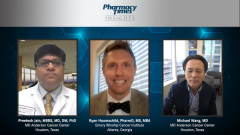
Developing an Optimal Treatment Pathway for Patients With MCL
The experts discuss their decision-making process in selecting treatment for patients with mantle cell lymphoma.
Episodes in this series

Ryan Haumschild, PharmD, MS, MBA: When we talk about future therapies, before we get to clinical trials, how are you sequencing BTK [Bruton tyrosine kinase] inhibitors and CAR [chimeric antigen receptor] T-cell therapy? Are you seeing any innovative combinations in this space in later lines of therapy? How are you managing those synergistic toxicities in combinations that are at the forefront of evidence?
Michael Wang, MD: In current practice, the only CAR T-cell therapy that has been approved for mantle cell lymphoma in the relapsed setting is brexucabtagene autoleucel. The trade name is Tecartus. The trial for this therapy was done in patients with prior BTK exposure. The trial eligibility required prior BTK. But when the FDA approved the therapy, it said that the indication didn’t have to include a prior BTK inhibitor. The indication is broader. You can use with or without prior BTK exposure. We mainly use it in the relapsed setting after 2 prior lines of therapy. But if the patient has higher risk, we use it in the second line. We’ve used it in many cases here at [The University of Texas] MD Anderson [Cancer Center].
In the future, for high-risk patients with a TP53 mutation, a Ki67 over 50%, and blastoid or pleomorphic variant, Dr Jain and I have designed a clinical trial with acalabrutinib and rituximab as a leading induction, followed immediately by CAR T-cell consolidation in the first-line setting. This is called the WINDOW-3 study. The PI [principal investigator] is Dr Jain, and we’re working together. We’re excited and in the process of activating this study.
Preetesh Jain, MBBS, MD, DM, PhD: To add to the very great comments from Dr Wang, your question was more on the toxicities that we might have encountered. Clearly, there’s no sequence because we aren’t sequencing at that conjunction, like BTK inhibitor followed by CAR T. If the patient has progressed then you go to only….
There are 2 other ongoing studies in relapsed mantle cell lymphoma where they’re giving a different CAR T agent with ibrutinib in the relapsed setting. Those trials are going on, one in Australia and other at City of Hope [in Duarte, California]. In large cell lymphoma, it’s also being reported by the Seattle group. In the CLL [chronic lymphocytic leukemia] setting, they noticed excessive toxicity with ibrutinib followed by CAR T in that small cohort that was reported in the Ohio State [University] group, including one of the cardiac deaths. We don’t have data in mantle cell lymphoma to answer that question, but our study will answer lot of those questions.
Ryan Haumschild, PharmD, MS, MBA: That’s the exciting thing about studies. We start to combine therapies. We know that the mechanisms of action can complement one another and be more effective when we think about that human element and the biology, which all comes back to the pathophysiology in alleviating the treatment.
When we think about some of these later lines of therapy, at what point do you recommend enrolling patients in investigational therapies and trials? What factors into your decisions when you do that?
Preetesh Jain, MBBS, MD, DM, PhD: In [The University of Texas] MD Anderson [Cancer Center] setting, it’s everybody right and left, whether it’s the first line, second line, third line, or fifth line. We always consider clinical trials our top priority. But if the patient isn’t ready to stay in Houston or follow up or something, then we look into patient comorbidities, patient preference, and what the best option is for the patient. We communicate with the local oncologist, consider the patient’s clinical profile, and then advise a standard-of-care BTK inhibitor therapy in the second-line setting if the patient is physically fit, with no cardiac issues, and is willing to take the treatment locally.
If the patient has significant comorbidities and there’s very advanced high-risk mantle cell lymphoma, then we bring into consideration the option of best supportive care. Unfortunately, that’s also one of the strategies that we consider when the patient has already progressed on multiple lines of therapy with very advanced age or advanced highly refractory cancer. Clearly, those patients aren’t candidates for CAR T-cell therapy. Cell therapy is a complicated thing, even though it’s approved by the FDA. It has to be used in a context of a particular patient with performance status and comorbidities considered. That’s how we approach it in a broad way.
Michael Wang, MD: Dr Jain and I are trying to develop a clinical trial system that covers every part of mantle cell lymphoma at any stage in pretty much all the common scenarios. For example, we have front-line studies. We even have studies for smoldering mantle cell lymphoma, which isn’t usually treated. We have first line, second line, and third line. We have CAR T. We have many studies in almost every category. We want to aggressively advance the field of mantle cell lymphoma.
Ryan Haumschild, PharmD, MS, MBA: The upcoming research is very exciting to me, especially seeing the unique clinical trials coming forward with CAR T and nonchemotherapy, nontoxic therapies, that you mentioned is one of your goals. It’s an exciting future.
Transcript edited for clarity.
Newsletter
Stay informed on drug updates, treatment guidelines, and pharmacy practice trends—subscribe to Pharmacy Times for weekly clinical insights.







































































































































































































